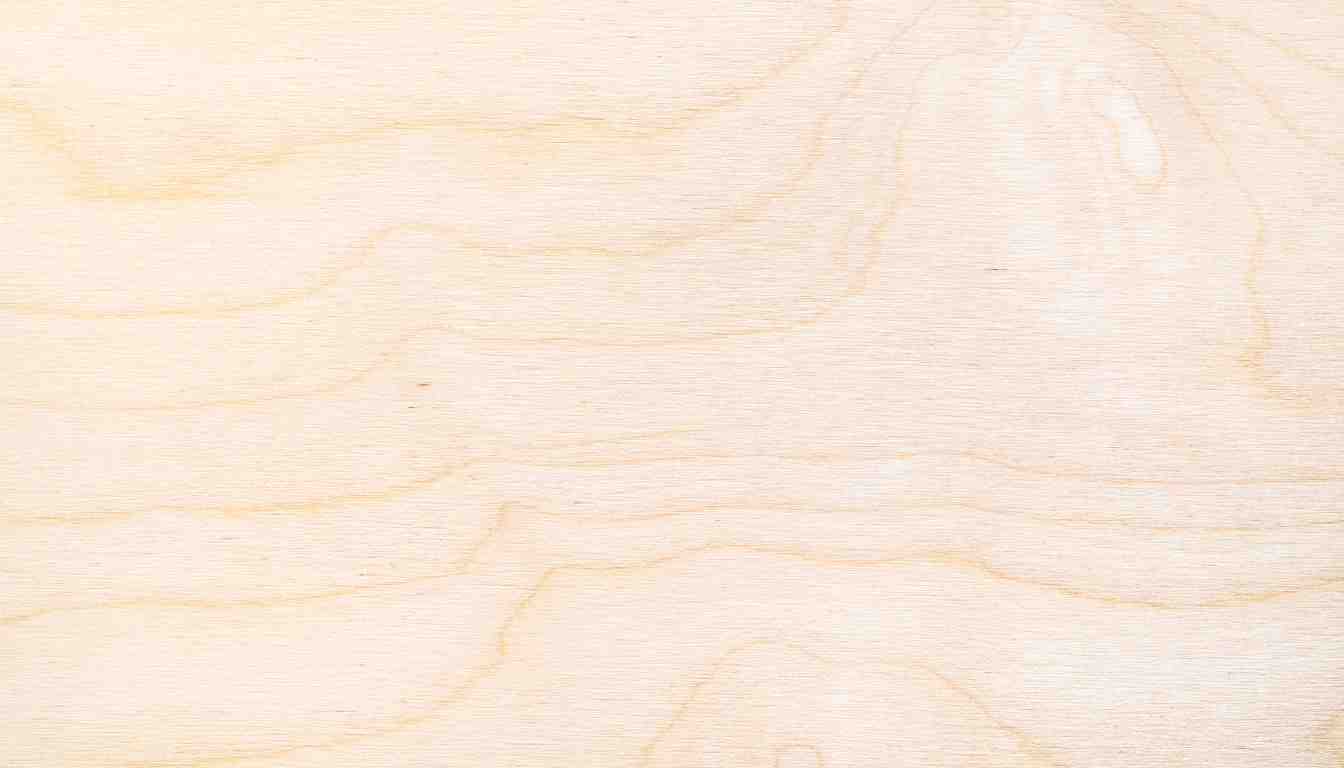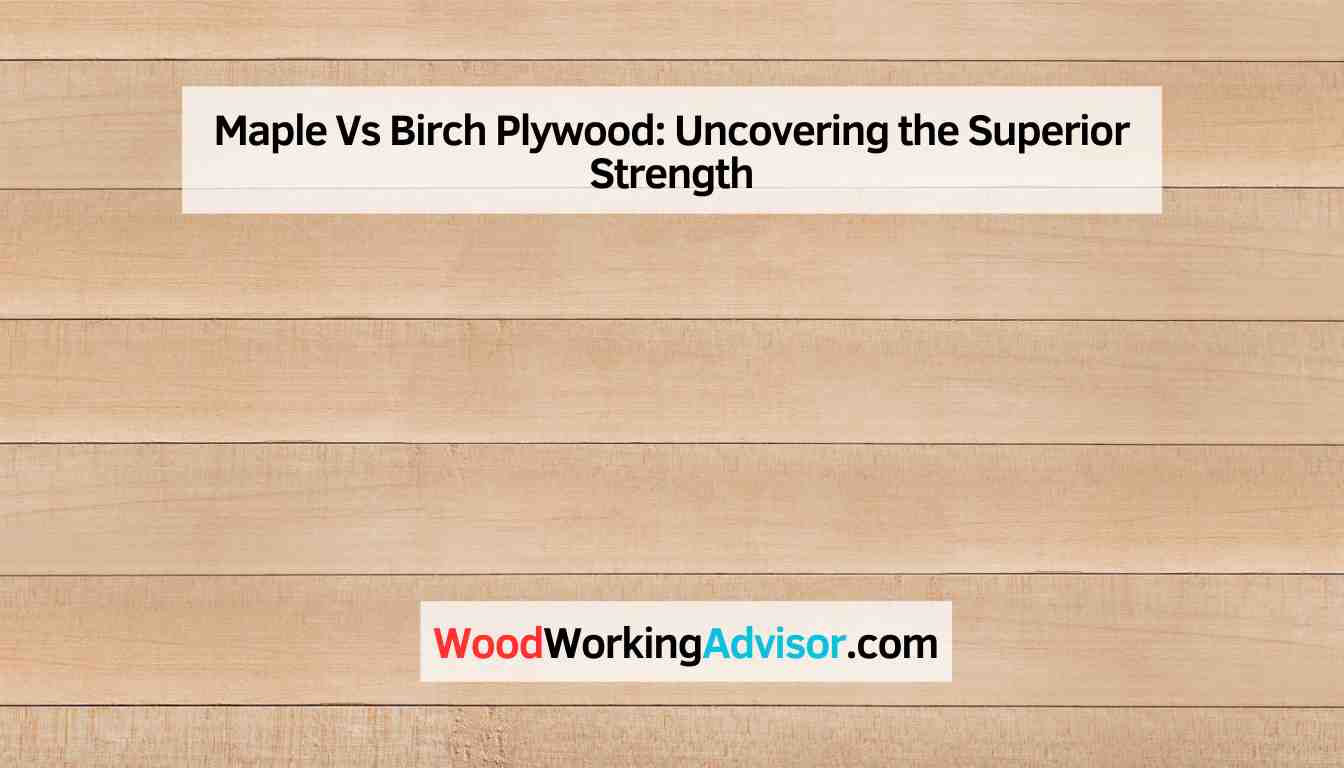Maple plywood offers a lighter color, exceptional strength, and stability, while birch plywood provides a pale yellow hue, good durability, and affordability. In interior design and furniture making, choosing the right type of plywood is crucial.
Understanding the differences between maple and birch plywood can help in making informed decisions. Maple plywood, known for its light color, offers excellent strength and stability, making it suitable for high-end furniture. On the other hand, birch plywood’s pale yellow hue, good durability, and affordability make it a popular choice for cabinets, shelves, and other decorative projects.
Both types of plywood have unique characteristics that cater to different design requirements and budgets. Exploring the specific features and applications of each can guide individuals in making the right choice for their projects.
What Is Maple Plywood?
Maple plywood is a durable and versatile wood material used in various industries. When comparing maple and birch plywood, maple stands out for its distinct grain patterns and lighter color, making it a popular choice for furniture, cabinetry, and decorative applications.
Maple plywood is a versatile and popular type of plywood that is constructed from layers of maple wood veneer. It is made by gluing together several layers of maple veneer, which are either rotary cut or sliced from logs. These layers are cross-laminated to enhance the strength, stability, and durability of the plywood.
Properties Of Maple Plywood
Maple plywood is renowned for its exceptional qualities, making it a preferred choice for a wide range of applications. Here are some key properties of maple plywood:
- Strength: Maple plywood is known for its high strength and durability, making it suitable for demanding applications that require long-lasting performance.
- Stability: The cross-lamination of maple veneer layers in plywood reduces the tendency of the wood to warp or shrink due to changes in humidity or temperature. This stability makes it an ideal choice for applications where dimensional accuracy is crucial.
- Smooth Surface: Maple plywood has a smooth and uniform surface, making it easy to finish with paints, stains, or clear finishes to achieve the desired aesthetic appeal.
- Natural Beauty: Maple plywood showcases the natural beauty of maple wood, with its light color and subtle grain patterns. This makes it suitable for applications where aesthetics are important.
Common Applications Of Maple Plywood
Due to its desirable properties, maple plywood finds applications in various industries. Some common applications of maple plywood include:
| Kitchen Cabinets | Shelving | Furniture | Architectural Millwork |
|---|---|---|---|
| Maple plywood is often used to construct kitchen cabinets due to its strength, stability, and attractive appearance. | It is a popular choice for shelving units as it can support heavy loads without sagging or warping. | Many furniture pieces, such as tables, chairs, and cabinets, are made from maple plywood for its durability and aesthetic appeal. | Architects and designers use maple plywood for architectural millwork projects, including wall panels, doors, and trim. |
With its exceptional properties and versatility, maple plywood is a reliable and visually appealing option for various applications in woodworking, construction, and interior design.

What Is Birch Plywood?
Birch plywood is a type of engineered wood made from thin layers of birch veneers. Compared to maple plywood, it offers a lighter weight and a more uniform appearance, making it a popular choice for furniture, cabinets, and interior design projects.
Birch plywood is a type of engineered wood that is made from thin layers of birch veneer that are glued together. It is a versatile and durable material that is widely used in various industries and applications. Birch plywood is known for its strength and stability, making it an ideal choice for projects that require a high-quality and reliable material.
Properties Of Birch Plywood
Birch plywood possesses a range of properties that contribute to its popularity in the construction and woodworking industries. Here are some key properties of birch plywood:
- Birch plywood is well-known for its strength and durability, thanks to its cross-banded layers that provide excellent stability and resistance to warping.
- It has a smooth and consistent surface, making it suitable for various finishes and applications that require an even and attractive appearance.
- With its high density, birch plywood offers excellent screw-holding capability, making it ideal for furniture and cabinetry applications.
- Its natural resistance to moisture and humidity makes it less prone to swelling or shrinking, ensuring its stability over time.
- Birch plywood has outstanding load-bearing capacity, making it suitable for use in structural applications such as flooring and roofing.
Common Applications Of Birch Plywood
Due to its exceptional properties, birch plywood is widely used in a variety of applications. Here are some common uses of birch plywood:
- Furniture manufacturing: Birch plywood is a popular choice for creating high-quality furniture pieces such as cabinets, tables, chairs, and shelves.
- Interior design: Its smooth and consistent surface makes birch plywood a preferred material for wall paneling, flooring, and decorative elements in interior design projects.
- Crafts and hobbies: Birch plywood is a favored material for artists, craftsmen, and hobbyists for creating intricate and detailed projects such as model airplanes, dollhouses, and puzzles.
- Construction industry: Birch plywood is utilized in construction applications like roofing, flooring, and concrete formwork due to its strength, stability, and resistance to moisture.
- Marine applications: Its resistance to moisture and humidity makes birch plywood well-suited for marine applications like boat building, interior fittings, and decks.
Overall, birch plywood is a versatile and reliable engineered wood material that offers an array of benefits in terms of strength, durability, and stability. Its various properties and common applications make it a preferred choice for numerous projects across industries.
Strength And Durability Comparison
Maple plywood offers exceptional strength and durability, while birch plywood boasts impressive resilience and sturdiness. Both options provide sturdy and long-lasting solutions for various woodworking projects.
The strength and durability of plywood are essential factors to consider when selecting the right material for your project. Maple and birch are two popular choices known for their strength and resilience. In this section, we will explore the strength characteristics of maple plywood, the strength characteristics of birch plywood, and compare their durability.
Strength Characteristics Of Maple Plywood
Maple plywood is renowned for its exceptional strength, making it a popular choice in various applications. The wood from maple trees is dense and sturdy, providing excellent resistance to wear and tear. The interlocking grain pattern enhances its structural integrity, ensuring stability and durability. Maple plywood exhibits high bending and tensile strength, making it suitable for demanding projects that require durability and resilience.
Strength Characteristics Of Birch Plywood
Similar to maple plywood, birch plywood is renowned for its strength and stability. Birch trees yield wood with tight grains and an even texture, resulting in a material with superior strength characteristics. Birch plywood is highly resistant to warping, cracking, and splitting, making it ideal for applications that require load-bearing capabilities. The natural hardness of birch wood, coupled with its interlocking grain structure, contributes to its impressive strength characteristics.
Comparing Durability
Both maple and birch plywood are highly durable options, capable of withstanding heavy use and various environmental conditions. However, when it comes to durability, birch plywood has a slight advantage. Birch plywood generally offers better resistance to impacts, scratches, and abrasions compared to maple plywood. Its denser composition and tight grain structure contribute to its enhanced durability, ensuring the material remains intact and retains its original appearance for a longer duration.
In conclusion, maple and birch plywood both boast impressive strength characteristics, making them suitable for a wide range of applications. While maple excels in terms of bending and tensile strength, birch plywood offers better durability in terms of impact resistance and scratch resilience. When selecting between the two, consider the specific requirements of your project to determine which plywood will best suit your needs.

Considerations For Choosing Between Maple And Birch Plywood
Choosing between maple and birch plywood requires careful consideration of their qualities and applications. Both options offer durability and strength, but maple provides a smoother surface and a more uniform appearance, while birch offers a lighter weight and flexibility. Ultimately, the decision should be based on the specific project requirements and desired aesthetic.
When it comes to selecting plywood for your project, it’s important to consider various factors that can affect the outcome. Two popular options are maple and birch plywood, each with its own unique characteristics. By understanding the project requirements, aesthetic preferences, and budget considerations, you can make an informed decision about which type of plywood will best suit your needs.
Project Requirements
The first consideration when deciding between maple and birch plywood is the specific requirements of your project. Each type of plywood has distinct properties that may or may not be suitable for your particular application.
For structural projects that require strength and durability, both maple and birch plywood are excellent choices. However, if you’re looking for plywood that can withstand heavy loads or repetitive use, maple plywood is often preferred for its exceptional strength.
On the other hand, if your project involves intricate woodworking or requires flexibility, birch plywood may be more suitable. Birch plywood is known for its high quality, fine-grained surface, making it ideal for detailed finishes, cabinetry, or furniture making.
Aesthetic Preferences
The appearance of the plywood can greatly impact the overall look of your project. Maple plywood has a light, creamy color with occasional reddish-brown streaks, giving it a warm and inviting feel. Its subtle grain pattern adds a touch of elegance to any space.
Meanwhile, birch plywood has a pale yellow hue with light brown streaks, offering a natural and neutral look. Its consistent grain pattern creates a clean and contemporary aesthetic, making it a popular choice for modern designs.
Ultimately, the decision between maple and birch plywood will depend on your personal preference and the desired style of your project. Consider the existing decor or the desired ambiance you want to achieve before making your final selection.
Budget Considerations
Budget is often a significant factor when choosing plywood for a project. Maple plywood is generally more expensive than birch plywood due to its superior strength and hardness. If budget is a primary concern, birch plywood can provide a cost-effective alternative without compromising on quality.
Table: Cost Comparison of Maple and Birch Plywood
|———————-|——————–|
| Plywood Type | Cost |
|———————-|——————–|
| Maple Plywood | Higher Cost |
| Birch Plywood | Lower Cost |
|———————-|——————–|
It’s important to note that cost should not be the sole deciding factor. Consider the other aspects mentioned above to ensure you’re choosing the plywood that best meets both your budget and project requirements.
In conclusion, when choosing between maple and birch plywood, it’s vital to consider the project requirements, aesthetic preferences, and budget considerations. By evaluating these factors, you can select the ideal plywood for your project and achieve outstanding results that meet both your functional and visual needs.
Conclusion
To determine the best choice between maple and birch plywood, it’s important to consider their unique characteristics. While maple plywood offers superior strength and durability, birch plywood excels in terms of versatility and affordability. Ultimately, the decision should depend on the specific project requirements and budget.
Whether you prioritize strength or cost-effectiveness, both types of plywood can deliver exceptional results. Choose the one that aligns with your needs, and let your project stand out with the right choice.


